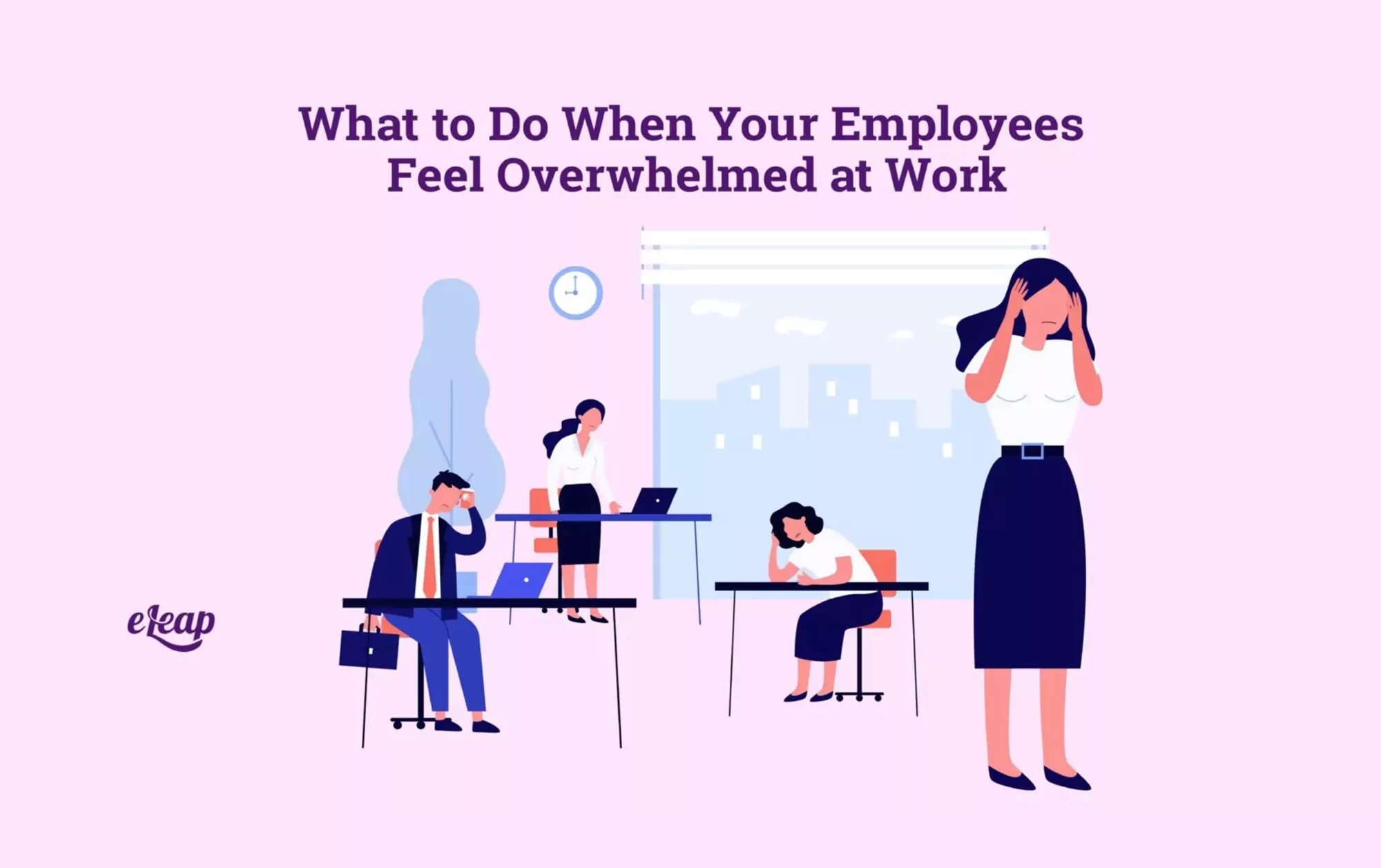What to Do When Your Employees Feel Overwhelmed at Work

Feeling overwhelmed at work is a common problem for people in today’s society. Pressures abound, a competitive edge is necessary, and someone always wants more than the employee can give.
Overwhelming experiences lead to burnout more quickly than people realize. Humans are built to experience stress and overcome it; stress can even be healthy sometimes. However, when that stress and overwhelm happen every single day without reprieve, burnout is inevitable.
Employee burnout, or feeling a constant sense of overwhelming feelings at work, is so common that the World Health Organization now classifies it as a syndrome. This syndrome is categorized by:
- Exhausted and/or depleted feelings
- “Checking out” from one’s responsibilities
- Negative or cynical feelings toward one’s work
- Reduced efficiency or productivity
Burnout affects your business and profitability in a downward spiral. Employees feel overwhelmed and can’t handle the stress. They quit, which lowers your retention rate and causes you to scramble for new hires. These new hires are onboarded and trained, but that creates more work for everyone, continuing the cycle.
The bottom line is that overwhelm and burnout cost you money. Therefore, you must notice when employees are feeling overwhelmed at work. Then, take steps to adjust the workplace culture and role responsibilities to ensure higher morale.
Increased overwhelming feelings at work are more and more common as years go on. It affects people at all stages of company hierarchies, too, not just people at the very top or very bottom of the company ladders.
One of the reasons that workplace stress affects us so much is that everyone experiences stress in all areas of their life. People undergo pressure from:
- Family life
- Financial burdens
- Social dos and don’ts
- Health-related issues
These stresses all compound and keep us from living our healthiest lives (mentally, physically, and emotionally).
You can’t control all the stressors in your employees’ lives. However, you can ensure that work (where they spend most of their waking time) is a healthy, motivating atmosphere. This heightens morale and creates a safe space where people want to be, instead of a toxic environment that adds to the problem.

Help Your Employees to Feel Less Overwhelmed at Work
You need employees who bring their best to the table. Competitive and profitable employees are:
- Engaged
- Motivated
- Productive
- Efficient
- Collaborative
- Positive
They can’t achieve this, though, when they are constantly stressed and overwhelmed. So, here are some ideas to implement to create a healthy workspace for your team.
Learn the Signs of Overwhelm at Work
It’s difficult to see yourself from an honest perspective. As the boss, you have the opportunity to notice things about others that they don’t notice about themselves. Red flags for constant stress in the workplace include, but aren’t limited to:
- Showing up late
- Increased sick days
- Missed deadlines
- Lowered levels of productivity
- Isolation from colleagues
Stress affects our bodies, too. Especially when we don’t deal with the emotions we’re feeling, it comes out through physical signs. Physical symptoms of burnout often present as:
- Headaches
- Irritability
- Complaining of aches, pains, or digestive issues
When you see that people are struggling with multiple issues such as these, step in. Speak to them one-on-one about what you notice. Ask them what they are struggling with and what support they need.
Then, take steps to guide them in the right direction. Offer mental health resources and follow up to ensure that they used them. Readjust workloads to better fit their needs or purpose. Connect them with team members who can offer guidance and support in their particular roles.
Check In, Even When Things Seem Fine
Problems are always more difficult to solve when they’ve taken root. Instead, try to nip overwhelm in the bud and keep it from happening in the first place.
Let’s say you assigned a new project to a team. You detailed the roles and responsibilities, the timeline, and the end goal. After a couple of days, check in with each person one-on-one and ask how they feel about the requirements. Can they make it work with their other tasks? Is the schedule realistic? Do they work well with the project partners?
Some employees feel that presenting negative feedback or admitting to struggles is seen as a weakness. Instead, show that you appreciate honesty by offering the opportunity to admit stress.
When team members feel that they can be transparent and in need of help, they are more likely to address it early on. This keeps small issues from turning into catastrophes.
Offer Flexible Scheduling
Our society is constantly evolving. The high cost of living today makes it necessary for almost all families to have two working people. Children’s education and extra-curricular pressures add to this stress. People take it on because they have to, but that doesn’t mean it’s easy or sustainable in the long run.
Be a forward-thinker. Recognize the fact that working from home often makes people more productive in that they save time with commutes, transitions, and childcare drop-offs. Those who can have a day or two to work out of the office often show that they are more efficient when they do come in because their stress is lower.
Empowering people to make their own choices about scheduling also increases morale. Think about what your end goal is. Is it to finish projects with high-quality work? Or is it to check off 40 hours for each person at their desk each week? Note that these aren’t always connected. People who feel that they are slaves to their jobs aren’t fulfilled or efficient.
Giving team members more autonomy in how and when they get their work done builds trust. As long as they meet deadlines and produce high-quality work, what does it matter where it happens?
Remember that happier employees are more likely to stay around. This saves you time, money, and manpower in hiring new people at every turn. Besides, without changes, these new employees will eventually burn out, too.
Don’t Shy Away from Appreciation and Recognition
Yes, many people believe that we live in an “everyone gets a trophy just for showing up” culture. We aren’t advocating for praising people for mediocrity or for simply doing the bare minimum. However, it is important that people are recognized for their hard work.
It’s human nature to desire appreciation. It makes us feel seen and important. As well, people often don’t see the wonderful things they’re doing from an outside perspective. A boss who takes the time and energy to point out the positive shows that they value their employees.
Creating a workplace culture of respect and recognition has long-term ripple effects, too. People who feel uplifted and encouraged go forth and give that to their colleagues. Happy, appreciated employees turn around and offer better service to clients and customers.
Meet Regularly about Roles and Responsibilities
Oftentimes, job details change from month to month or task to task. Managers who oversee large departments or who have dozens of employees can’t know what everyone is doing on a daily basis.
Therefore, meet with people regularly to discuss what’s on their plates. This way, you don’t assign tasks and projects that people can’t fit on their plates along with their regular workloads.
High-ranking or over-performing employees don’t usually want to admit that they can’t handle something. However, as we mentioned before, when you open the door with a question it’s more likely that people take the opportunity to discuss alternatives.
This is another area in which you give your employees the place to advocate for themselves. People who take ownership of their workload produce higher-quality, more efficient work. This creates people who are more invested in the company and themselves.
Create a Culture of Wellbeing and Mental Health
Opening up these conversations with your employees shows that you value healthy boundaries. Boundaries are a buzzword right now, but with good reason. Most Americans did not grow up learning to set healthy boundaries for themselves, especially regarding work. Help change this in your own small circle.
Make mental and physical health an office priority. You can do this in myriad ways, such as:
- Set up a meditation or low-stimulation space where people can go to take a breather.
- Organize 15-minute walks around the office neighborhood in the mid-afternoons to re-energize people.
- Keep the breakroom stocked with healthy snacks instead of typical junk food.
- Show that you take part in bettering your health.
- Give positive affirmation to others when they make healthy choices.
You set the tone for the office. Choose positivity, honesty, and appreciation as your foundational values. Focus on the small things you can implement into your daily routine and culture, and watch the positive effects come through.
Conclusion
As a manager, be proactive about noticing situations that often cause stress among your team members. Talk about it, offer solutions and feedback, and follow up with your employees. Showing that you care opens the door for people to come to you when they need help.